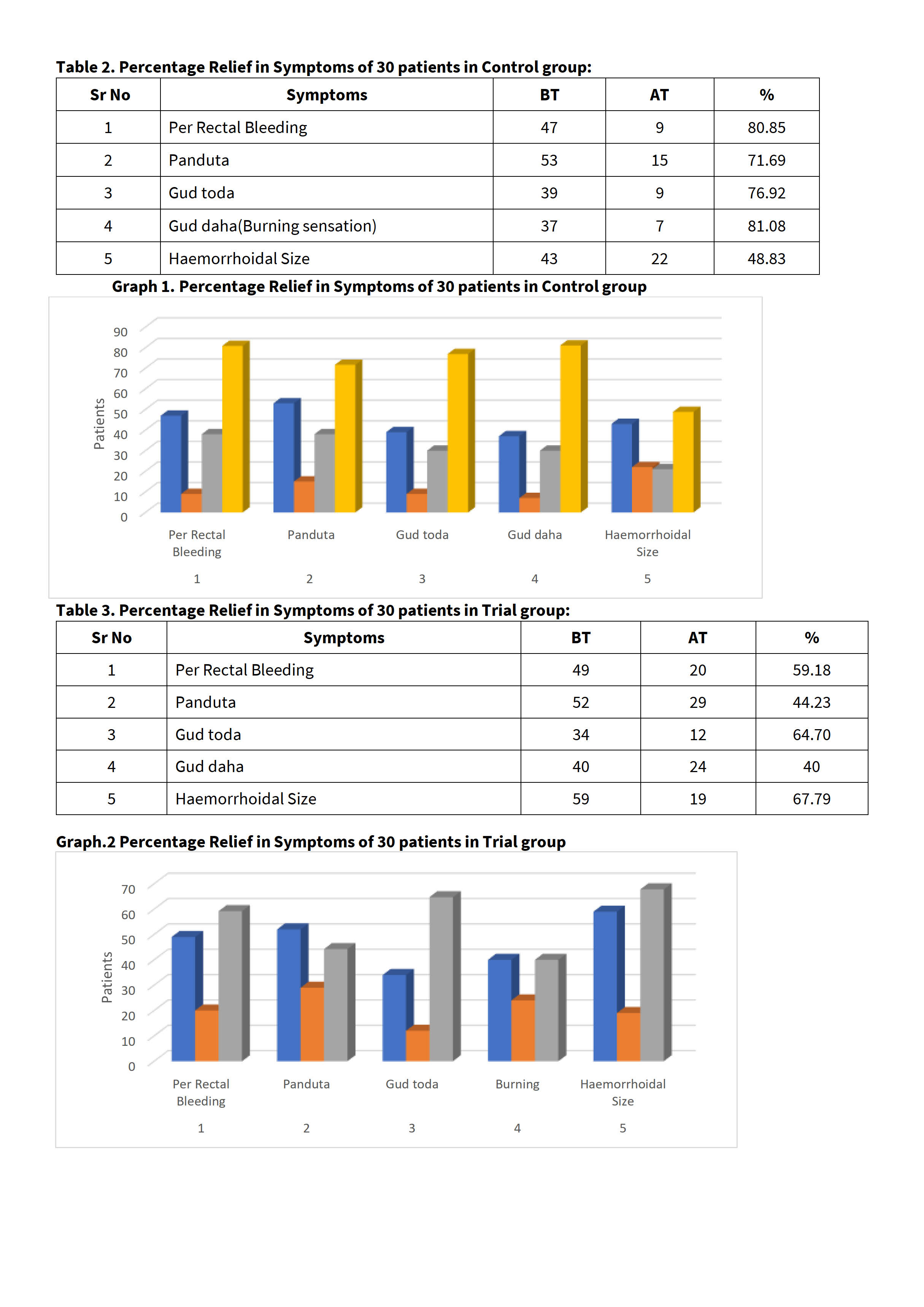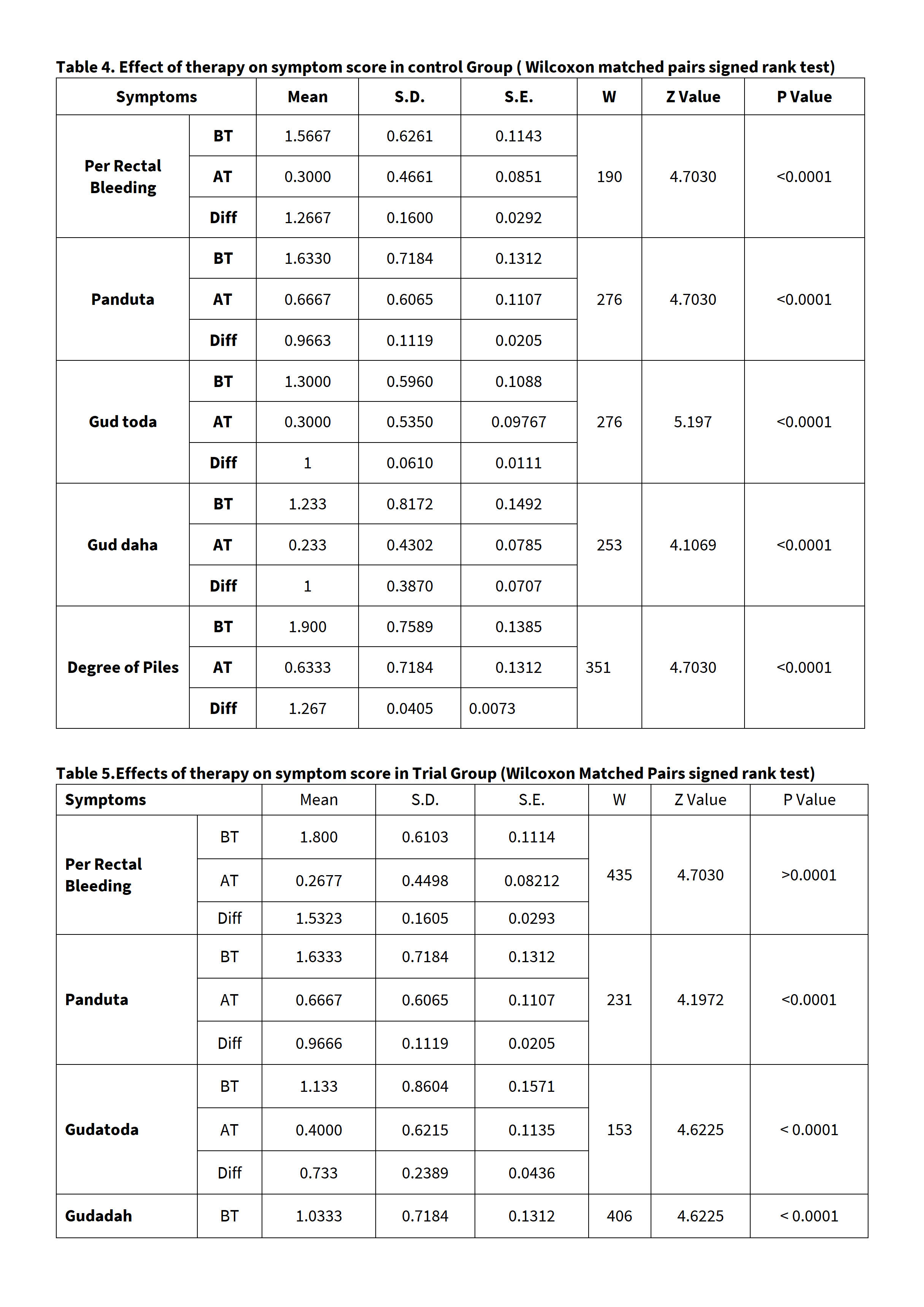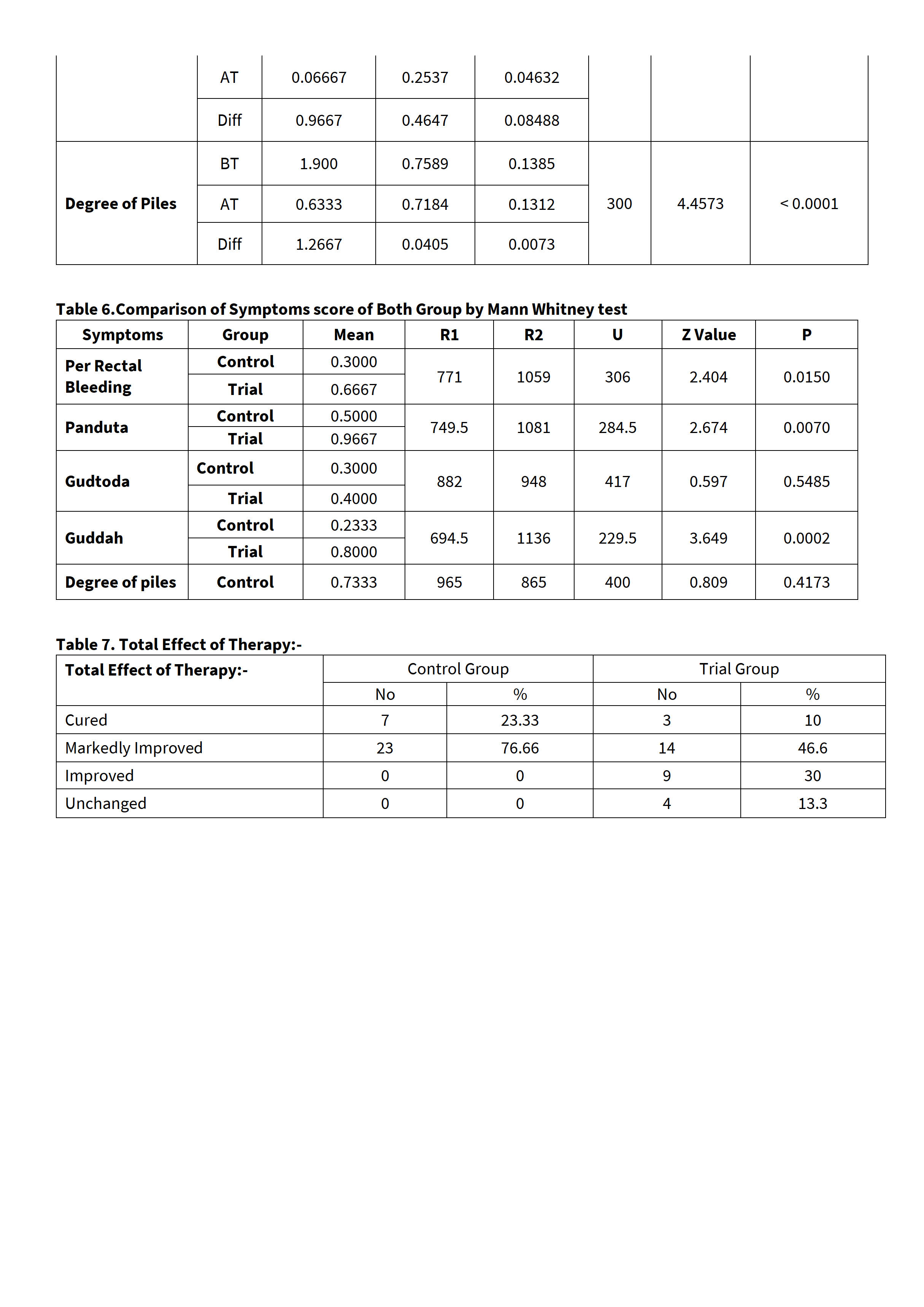Original Article
Year: 2021 |Volume: 2 | Issue: 05 |Pages: 23-32
STUDY OF EFFICACY OF KUSHAMOOL YOGA IN THE MANAGEMENT OF RAKTARSHA.
About Author
Correspondence Address:
Dr Vaibhav R Manjare Assistant professor shalya department, Shri K R Pandav Ayurved college, Nagpur. Email: vaibhav.manjare7@gmail.com Mobile no 9890620016
Date of Acceptance: 2021-05-19
Date of Publication:2021-06-05
Article-ID:IJIM_74_06_21 http://ijim.co.in
Source of Support: NIl
Conflict of Interest: NIL
How To Cite This Article: Manjare VR, Rathod SP, Borse NV, Dakhole PP. “Study of Efficacy of Kushamool Yoga in the Management of Raktarsha. Int. J Ind. Med. 2021;2(5):23-32
Abstract
Background: . According to Acharya Sushruta, arsha (hemorrhoids) is included in ashta mahagada on the basis of the predominance of Dosha, Arsha are classified as Vataj, Pittaj, Kaphaj, Raktaj and Sannipataj. Objectives: To assess the efficacy of Kusha mool yoga and Nagakeshar churna in management of Raktarsha. Methods: Total 60 patients of Arsha (?? and ??? internal haemorrhoids) having age group 20 to 60 years of either sex recruited in this study and divided into two groups. Results : Out of total 60 cases, incidence of Arsha is observed in 45(75%) male and in 15(25%) female patients, while 22(36.66%) patients were vegetarian and 38(63.33%) non-vegetarian patients. After conducting the clinical trial based on clinical parameters, in 1st and 2nd degree internal piles Kusha mool yoga and Nagakeshar churna are both effective as a conservative treatment options without a need of surgery. Conclusion : Both the drugs are easily available cost effective as in Kusha mool yoga the anupaan tandulodak is easily made at home. Nagakeshar churna is more effective in gudtoda and pandutwa in Raktarsha.
Keywords: Arsha, raktarsha, anupaan, tandulodak, Kusha mul
Introduction
In today’s running life people don’t get any enough time for exercise, healthy diet. Due to changing living and working lifestyle many are suffering from the dispersers like haemorrhoids. Most of people have a job of sitting for lengthy time, they eat food which is fast food and more spicy and contains very less fibres which leads to constipation and further it tends to of Arshas. According to Acharya Sushruta , Arsha (hemorrhoids) is one such grave disease, for which it has been included in Ashta mahagada.[1] The treatment of Ayurved is mainly based on treatment of Agni. [2] Most of the diseases described in Ayurveda is due to rearranged function of Agni. [3] Arsha is a disorder where mandagni, a patient suffers from per rectal bleeding in Raktarsha. It is characterized by bleeding and protruding mars per anum. In Arshas they become thrombosed, prolapsed. On the basis of the predominance of Dosha the arsha are classified as Vataj, Pittaj, Kaphaj, Raktaj and Sannipataj. [4,5] The classification according to the Prolapse is 1st and 2nd degree haemorrhoids are those which bleed but do not prolapse outside the anal canal and which prolapse outside the anal canal during defecation and reduce spontaneously itself respectively. Next, 3rd degree which prolapse outside the anal canal during defecation and goes back manually while 4th degree haemorrhoids are permanently prolapse outside the anal canal.[5] Various treatment for Raktarsha have been described in Ayurvedic Samhitas. Basically, four types of treatments are given, viz. Bheshaj Chikitsa (palliative treatment), Kshara Karma (potential cauterization agent therapy), Agnikarma (direct cauterization agent therapy) and Shastra Karma (operation by sharp instrument).[6,7] In various Samhitas Acharyas gives Aushadhi yogas to treat Raktarsha. [8] Acharya Vangasena describes as easy which is used internally i.e., Kushmool yogas in Raktarsha. It helps to reduce bleeding and other symptoms of Raktarsha.
Objectives:
- To assess the efficacy of Kusha mool yoga and Nagakeshar churna in management of Raktarsha.
- To evaluate the efficacy of Kusha mool yoga in comparison with Nagakeshar churna.
Methodology:
The clinical study was carried out at department of Shalyatantra of the hospital. Total 60 patients of Arsha (?? and ??? internal haemorrhoids) of either sex recruited in this study and divided into two groups. Diagnosis is made after history taking and thorough local examination and proctoscopy. A well-Informed written consent of the patient is taken before the treatment.
Inclusion criteria- Patients of age group 20 to 60 years of either sex and having 1st and 2nd degree internal haemorrhoids of all position.
Exclusion criteria- A known a case of Hypertension, Thrombosed haemorrhoids, Haemorrhoids with ulcerative colitis, HIV or HbSAg positive patients, prolapse of rectum, Fissure-in-Ano, Fistula-in-Ano, crohn’s disease, Ca rectum, Tuberculosis patients, External haemorrhoids were excluded.
Withdrawal criteria: The patients were withdrawn from the trial if occurrence of serious adverse effects and Patients who were not willing to continue the trial.
Criteria for assessment:
-
Per Rectal Bleeding
-
Panduta
-
Gud toda
-
Gud daha(Burning sensation)
-
Haemorrhoidal Size
Table 1. Group Management:
|
Index |
Trial group |
Control group |
|
Drug |
Kusha mool churna and Bala mool churna with tandulodak. |
Nagkeshar churna with Loni and sharkara |
|
Dose |
1 gm twice a day |
1 gm twice a day |
|
Time |
before each meal |
before each meal |
|
Duration |
28 days |
28 days |
|
Sample size |
30 |
30 |

Table 1

table 2

table 3
Observations & Results :
In control Group, 17(56.6%) patients were in the age group of 20 to 40 years and 13(43.33%) patients were in the age group of 41 to 60 years. In trial Group, 16(53.33%) patients were in the age group of 20 to 40 years and 14(46.66%) of patients were in the age group of 41 to 60 years. Out of total 60 cases, incidence of Arsha is observed in 45(75%%) male and in 15(25%%) female patients, while 22(36.66%) patients were vegetarian and 38(63.33%%) non-vegetarian patients. Out of total 60 cases, 36(60%) patients were doing sedentary type of work and 24(40%) patients were doing labour type of work.
Statistical Analysis of effects of therapy on parameters in Group A, by Wilcoxon Matched Pairs signed rank test, In parameters Per Rectal bleeding Sum of all signed ranks was 190, Z value was 4.7030 and P value was <0.0001, which was statistically extremely significant. Similarly, it was found significantly highly significant among symptoms like Panduta, Gudatoda, Gudadah, Haemorrhoidal Size as p value obtained was < 0.001 which was highly significant.
Statistical Analysis of effects of therapy on parameters in Group B, by Wilcoxon Matched Pairs signed rank test, in parameters Per Rectal bleeding Sum of all signed ranks was 435, Z value was 4.7030 and P value was <0.0001, which was statistically extremely significant. Similarly, it was found significantly highly significant among symptoms like Panduta, Gudatoda, Gudadah, Haemorrhoidal Size as p value obtained was < 0.001 which was highly significant.
Statistical Analysis of comparison of effects of study on both Group By Mann-Vitney Test
Per Rectal bleeding : -
Difference between symptom score of BT and AT in control was 1059 and that of group trial as 771. The difference of symptom score was 0.30 ± 0.46 for control group and 0.66±0.60 that of trial group. Z Value was 2.404 and p=0.0150<0.05, Statistical analysis shows that trial drug has better action in control of PR bleeding.
Panduta -
Difference between symptom score of BT and AT in Trial was 749.5 and that of control group was 1081. The difference of symptom score was 0.96±0.66 for trial group and 0.0.50±0.57 that of control group. Z Value was 2.67 and p< 0.0070<0.05, Statistical analysis shows trial drug has better action in control of Pain at anal region.
Gudtoda : -
Difference between symptom score of BT and AT in Trial was 882 and that of control group was 948. The difference of symptom score was 0.4±0.62 for trial group and 0.30±0.53 that of control group. Z Value was 0.59 and p=0.54>0.05, which is statistically not significant. Statistical analysis shows that there is no difference in both the group.
Burning sensation in anal canal : -
Difference between symptom score of BT and AT in Trial was 694.5 and that of control group was 1136. The difference of symptom score was 0.8±0.23 for trial group and 0.23±0.43 that of control group. Z Value was 3.64 and p=0.0002<0.05, which is considered statistically significant.
Haemorrhoidal Size: -
Difference between symptom score of BT and AT in Trial was 965 and that of control group was 865. The difference of symptom score was 0.63±0.71 for trial group and 0.73±0.58 that of control group. Z Value was 0.809 and p=0.4175<0.05, which is considered statistically not significant. Statistical analysis shows that that there is no difference in both the group.
As out of 30 patients of Control group 7 patients were cured, 23 patients were Markedly Improved, no patients were improved, while out of 30 patients of trial group 3 patients were cured,14 patients were Markedly Improved, 9 patients were Improved & 4 pt. Does not had any significant effect.
Discussion
Age wise distribution shows that there is total 16 patients in trial group and 17 in control group. This result shows the incidence of internal haemorrhoids is in the middle age (Age group of 20 – 40 years ) persons more suffering from ano-rectal problems. It could be due to the lifestyle, unusual food habits, bakery products, fast food, etc which is consumed more in middle age. There is also physical and mental stress in this age group. Sex wise , out of 60 patients under study 25% were female & 75% were male. This difference may be of shyness of female patient. Diet wise distribution of disease shows that out of 60 patients, 36.6% Patients had taking vegetarian diet while remaining 63.3% consumes both veg as well as non-veg foods. In trial group, 12 patients were having veg diet while 18 had taken mixed diet means both veg & non vegetarian diet. This shows that the patients having mixed diet are more prone to develop internal piles. Particularly both veg and non -veg diet taking people eat spicy foods in it out of 60 patients 71.6% people eat spicy and 28.3 % eat non spicy. Peoples had much quantity of spicy diet in it, causing constipation leading to increased abdominal pressure due to straining at stool, which later on develops internal piles. Trial group of 30 patients shows, 59.18 % relief in Per Rectal Bleeding, 44.23 % relief in associated panduta, 40 % relief in Burning Sensation while 67.79 % relief in Size of haemorrhoids. It indicates that kusha mool yoga has significant role on Internal Haemorrhoids than Nagakeshara churna in degree of piles, pain and PR bleeding with the help of. Chi-square test we concluded the result as p was <0.05. Relief was achieved in for the parameter per rectal bleeding in control group was 80.85% while in trial group is 59.18%.From Statistical analysis it shows that the both drugs are good in reducing the per rectal bleeding in internal haemorrhoids. In Panduta relief was achieved in control group is 71.69% while in trial group is 44.23%.The results of Mann Whitney Test, applied to compare the both groups, was extremely significant (P<0.05 ), from Statistical analysis it shows that the control group drug is good in reducing the panduta in internal haemorrhoids. Gudtoda relief in control group was 76.92% while in trial group is 64.70%.The results of Mann Whitney Test, applied to compare the both groups, was not significant (P>0.05). From Statistical analysis, it shows that drug of both groups had equivalent action on internal haemorrhoids in reducing gudtoda.
In Burning in Anal Canal, relief was achieved in control group is 81.08% while in trial group is 40.00%.The results of Mann Whitney Test, applied to compare the both groups, was extremely significant (p<0.05) From Statistical analysis, it shows that drug of trial group had equivalent action on internal haemorrhoids in reducing burning in anal canal. In Haemorrhoidal size in Group A, size was reduced up to 48.83% whereas in Group B it was reduced upto 67.79%. Results of Mann Whitney Test, applied to compare the both groups, was not significant (P> 0.05)
From Statistical analysis it shows that drug of trial group had good action on internal haemorrhoids in reducing hemorrhoidal size in anal canal. The study with these two drugs can be done on 3rd and 4th degree internal haemorrhoids patients who are not physically fit for surgery to assess whether they can reduce PR bleeding, pandutwa, gudtoda, guddaha and size of piles in a similar way as in 1st and 2nd internal haemorrhoids and can ease the life of these patients. Study was conducted in small sample size so large sample size gives a better result. Duration of study was also limited longer duration can reveal any new information.
Conclusion
After conducting the clinical trial based on clinical parameters, in 1st and 2nd degree internal piles Kusha mool yoga and Nagakeshar churna are both effective as a conservative treatment options without a need of surgery. Both the drugs are easily available cost effective as in Kusha mool yoga the anupaan tandulodak is easily made at home. Both groups had their effectiveness on particular symptoms regarding Raktarsh such as Kushmool yoga used to reduce symptoms like per rectal bleeding, guddaha and degree of piles than Nagkeshara churna. Nagakeshar churna is more effective in gudtoda and pandutwa in Raktarsha.
References
- Shastri A. Sushrutacharya, Sushruta Samhita, Ayurved Tatva Sandipika. Varanasi: Chaumbika Sanskrit Sansthan; 2001. Sutra Sthana0?33/4.10, p. 126-7.
- Godbole, Amrit, Sweta, Dr Abhinav,Singh. , Pharma Science Monitor 8(4), 2017, 15-20
- Charaka Samhita, Shastri K, Chaturvedi G., editors. Varanasi: Chaukhamba Bharti Academy; 2004. p. 461
- ShastriKaviraja Ambikadutta Sushrutasamhita (NidanaSthaana). Varanasi: Chaukhambha Sanskrit Sansthan; 2010. p.310
- S. Das. A Concise text book of Surgery Kolkata; Dr. Published by S. Das. 13, Old Mayor’s Court;2014.p.1075-1076.
- Shastri A. Sushrutaacharya, Sushruta Samhita Dalhanacharya Kaviraj. 11 th ed. Varanasi: Published Chaukhamba Sanskrit Sansthan; 1953, Chikitsa Sthana?6/03, p. 35.
- Ajai Kumar, Gupta Ajay Kumar. A Classical Review on Arsha(Haemorrhoids/Piles): Current Treatment Strategies and Future
- Prospects. International Journal of Ayurveda and Pharma Research. 2016;4(8):69-73
- Shastri Kaviraja Ambikadutta Sushrutasamhita (Nidana Sthaana).Varanasi: Chaukhambha Sanskrit Sansthan; 2010. p.306
- Hansa raj nidan. Saxena Nirmal, Vangsen Samhita/ chikitsa sangrah of vagsen. vol. II, chaukhamba Sanskrit, 2004.

